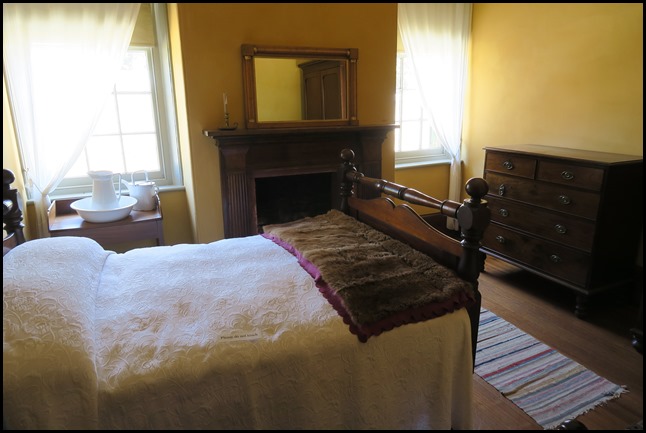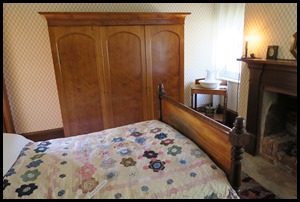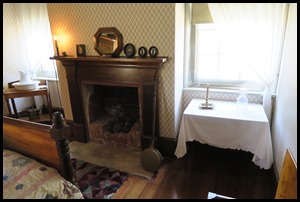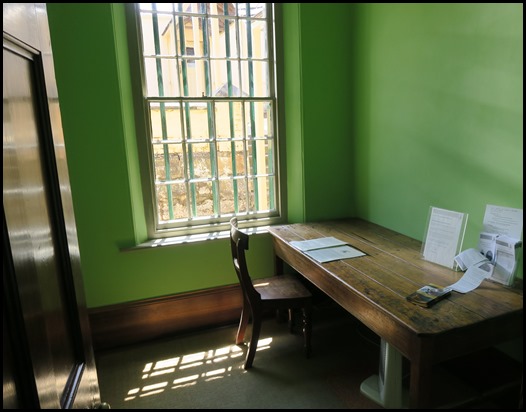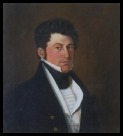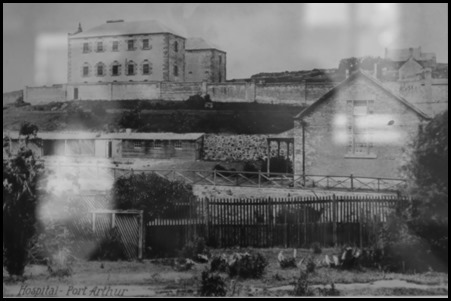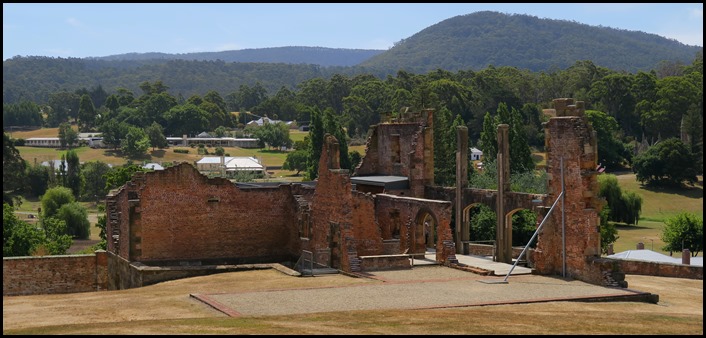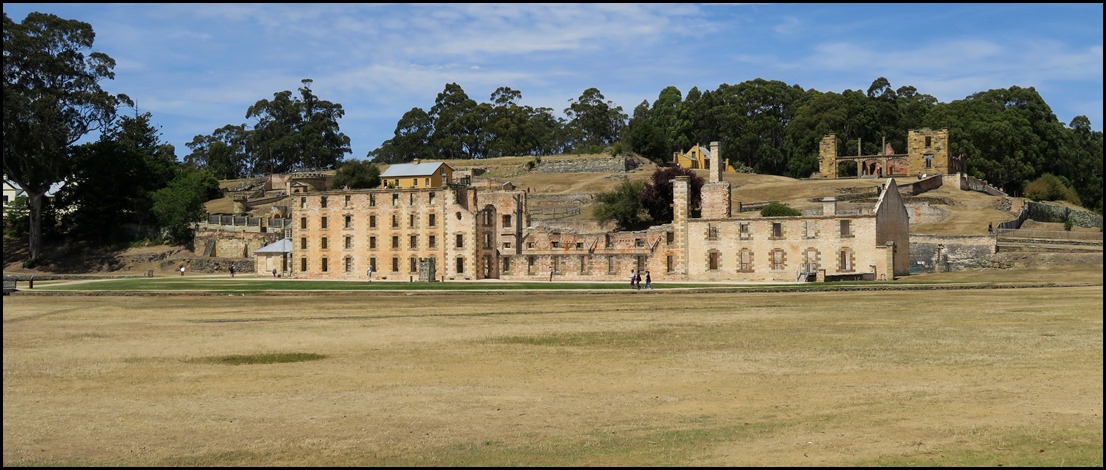PA Civil Officers' Row

|
Civil Officers’ Row at Port
Arthur
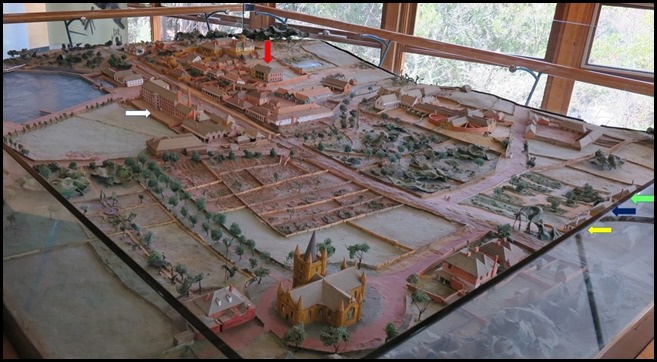 Civil
Officers’ Row separated senior officers and their families from the convict
population and provided them with housing suited to their status. The Government
Gardens offered a quiet and beautiful space free from the unwanted presence of
the convicts.
The aristocracy of Port Arthur consists of the
commandant, the visiting magistrate, the chaplain, the priest, and the surgeon.
These gentlemen have all pretty cottages surrounded with gardens near the
church. Lieutenant Colonel Godfrey Mundy, 1st of January
1858.
Model of the Site: Visiting Magistrate’s House
(green arrow). Roman Catholic Chaplain’s House (navy arrow). The Junior Medical
Officer’s House, (yellow arrow). The Penitentiary is marked with a white arrow
and the hospital with a red one.
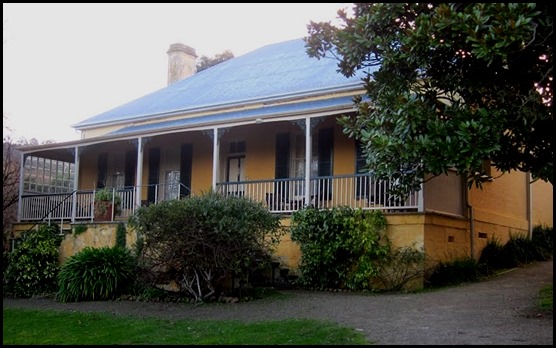 Visiting Magistrate’s House. The southern house of Civil
Officers’ Row was built in 1847 for the visiting magistrate, as staff moved around the penal establishments
on the Tasman Peninsula, a number of senior officials resided here, and
later housed the senior surgeon, it is the largest of the houses at a cost of
eighty eight pounds, seven shillings and four pence. The Visiting Magistrate
assisted the Commandant with disciplinary matters. He heard cases for any
offence, except murder, and determined punishments. The Senior Medical Officer was responsible for the
overall management of the hospital and performed surgical procedures, operated
an out-patient clinic for the military and visited families in their homes. One
of his most consuming duties was inspecting each prisoner when he first arrived
and any man who reported sick.
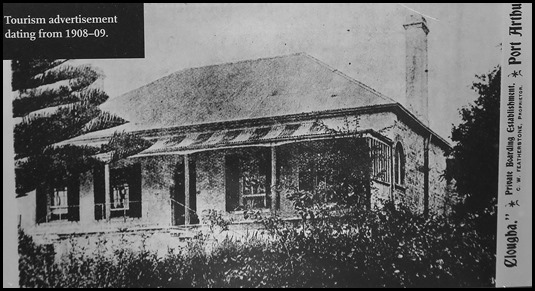 By the
1890’s, after the settlement closed, the house became a private Carnarvon
residence named ‘Clougha’ (pronounced Clotha) and then a private hotel. Clougha advertised gardens, orchards and shooting,
and promoted that the Cuisine Department is excellent and the Sanitary
Arrangements of the most perfect description.
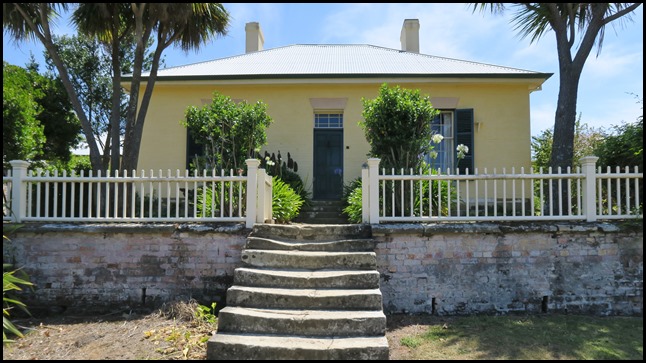 The Roman Catholic Chaplain’s Cottage, 1844. This small
cottage was built for Father William Bond, the first Catholic chaplain appointed
to the settlement.
Irishman Richard Jones was the
first convict to campaign for the appointment of a Catholic chaplain at Port
Arthur. Soon after arriving here, Jones presented the Governor with a petition
asking that he be excused from attending church services and worshipping
“against his beliefs”. After his request was denied, Jones refused to attend
church services and was punished with solitary confinement and the lash. He was
eventually treated as a ‘conscientious objector’ and was allowed to remain in
his cell. Support for Jones’ cause soon spread among the Catholic prisoners and
the Government was forced to submit to their requests and provide a Catholic
priest.
The Colonial Times reported on the
22nd of October 1844: A Catholic
priest, we understand, goes immediately to port Arthur. Such an appointment we
no doubt will prove acceptable to the Catholics of that place.
The house
is small, with only four rooms, and was intended for a single occupant. However,
a later priest, Father Fitzgerald, lived here with his sister and her female
servant. Father Fitzgerald found the house to be “wretchedly small” and wrote
that he felt “cribbed, cabined, confined, or rather coffined” by this cramped
accommodation......... A small room at the back of the house served as a private
chapel.
This
house became part of the Hotel Arthur in the first half of the twentieth
century.
 We timed it just right to be able to
sit for a few minutes in the shade - on the porch of the Junior Medical Officer’s House. Then listen to the history
of the house and be shown around by an informative guide.
The house was originally built for
Commissariat Officer Thomas James Lempriere, his wife Charlotte and large
family. They had previously lived in a condemned wooden cottage below the ruin
of the hospital and Lempriere threatened to resign if appropriate accommodation
was not provided for him. The family only lived here for seven months before
leaving Port Arthur. The doctor then took up residence and various subsequent
doctors probably stayed in the house until the 1870’s when the schoolmaster
moved in.
From 1921 until 1951 the house was
the Hotel Arthur and the cast and crew of the classic film For the Term of
His Natural Life stayed here when the film was shot in 1927.
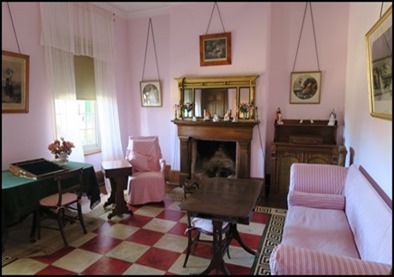  The pretty
sitting room. The house
has been restored and is a fine example of Georgian architecture, the rooms have
been furnished with items of the era.
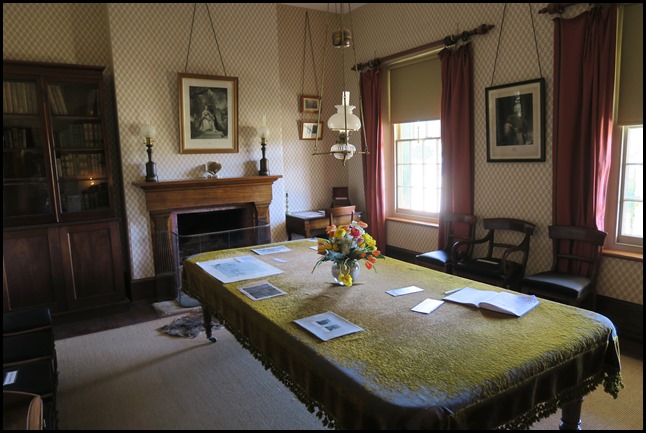 The dining
room. On the table was a drawing.
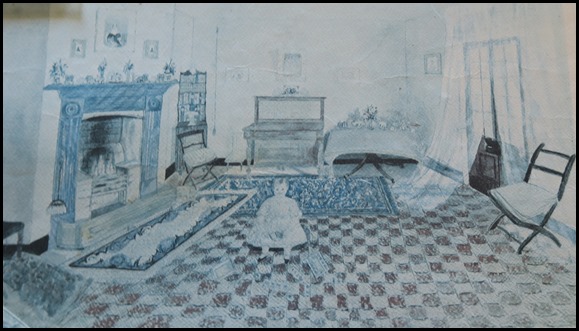 This is
the only surviving drawing of an interior at
Port Arthur. It shows a room like this one, with simple furnishings, muslin
curtains and rag rugs. Here, as in many rooms in many of the houses, walls have
been scraped back to determine the original colour. Distemper would have been
used in this period, made from a mixture of lime wash, natural ochres and milk
curd; horse or cow hooves are used as a binding agent.
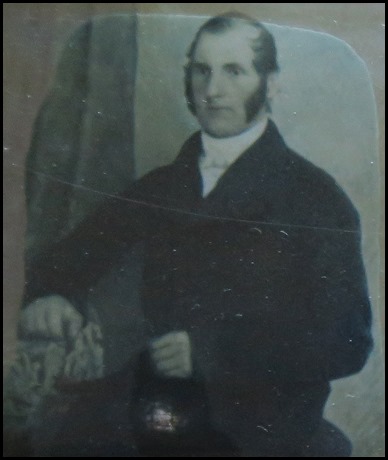 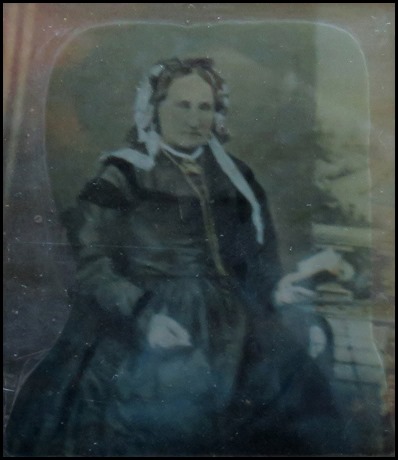 On the table were these pictures. Thomas Brownell was born on the 16th of December 1800 on the Caribbean island of St Christopher, the son of a Wesleyan missionary. He was married in Yorkshire in 1826 and in 1829, with his wife Elizabeth and their two children, he left to seek a new life in the Australian colonies. The family arrived in Hobart Town in April 1830. Brownell had intended to set up practice in Hobart Town but was offered and accepted the post of medical officer and catechist at Maria Island penal settlement, which then had been established for five years. With a salary of ₤50 a year, a comfortable home and an assigned servant, the family enjoyed their two years on the island. Brownell, an active Christian, was as much a religious instructor as a doctor, and when the family moved to Port Arthur in October 1832 he was the settlement’s sole catechist. He was succeeded in this role by Rev. John Allen Manton, with whom he enjoyed a close friendship for many years; he even named one of his children after him. In 1833 Brownell left Port Arthur, disappointed at the failure of his efforts to heal and reform the convicts. He found the prisoners generally degenerate, of ‘a reprobate mind’ and lost ‘to everything good and decent’. His efforts to reform were met with little effect. Discipline at Port Arthur he felt, was severe ‘bordering on cruelty’ but ‘just’. He obviously felt that strong methods were necessary to make an impression on these men. For seven years Brownell, sometimes with the help of Elizabeth (a schoolteacher), tried his hand at private medical practice, farming at Brighton, and religious instruction and teaching at Bridgewater penal station and Avoca in the Fingal valley. In December 1840, the family, now with 11 children, found itself back at Port Arthur with Brownell as medical officer in charge. His fifteen months there were very busy. Although he had three medical assistants, Brownell found the duties ‘arduous and extensive’ and took up another government post at George Town in 1843. The following year saw the family back on Maria Island, which had been reopened by the government as a penal settlement after closing in 1832. Then for five years until 1853 they were again in Hobart Town, where Brownell was a medical officer with the Immigration Department. In December 1853, the family moved to Port Arthur for a third time and this time stayed for nearly five years. This period seems to have been happy and settled, but Brownell was plagued by a rheumatic condition and was forced to retire in 1857. He died in Hobart in 1871. Elizabeth survived him by four years.
The main bedroom, back left of the house.
The second bedroom, back right of the house.
The office, middle room, back of house. On the table were some wonderful stories and we particularly liked two of them.
The Laundry Maid: This servant washes all the household and other linen belonging to her employers, and is assisted, generally, by the house maids; or the house maids, kitchen maids, and scullery maids wash for themselves. All the men servants find their own washing, except the footmen’s aprons and jackets. The foul linen is given out to her on Monday morning, and returned clean, on Friday night or Saturday morning. (Wages eight to fifteen pounds a year). Tow ounces of pearl-ash, to a pound and a half of soap, will make a considerable saving. Soda, by softening the water, saves a great deal of soap. It should be dissolved in a large jug of water, some of which should be poured into the tubs and boiler, and when the lather becomes weak, add more. The use of soft soap, saves nearly half in washing. Good new hard soap contains full half of oil, one third water, and the rest soda.
To Light and Manage a Parlour Fire: There is more art, perhaps, and more economy than is considered necessary in making well, and managing a fire. First rake out all the ashes, quite clean, leaving in the bottom of the grate a few light cinders, through which the air, from beneath, may pass freely; upon these lay shavings, or waste paper, and then wood, the smaller pieces under, of course, and the whole crossing each other promiscuously, and in all directions; throw cinders behind, and some at the sides, to fill out the grate, and in the front, between the bars, put small knobs of fresh coals, with some larger knobs at top, and a little small coal behind, but not so much at first as to prevent a draft of air through the grate at the top. The fire, thus prepared, may be lighted with a match, and will kindle well of itself, whilst the ashes are taken up, and the fireplace cleaned. When it is found necessary to blow a fire, do not thrust the nose of the bellows between the bars, but keep it at an easy distance from the fire, and rather below the centre of the fire, that so, the air may be dispersed around to a considerable distance in front of the fire. When you stir a fire, always put the poker between the secon and third bars. – After you have stirred the fire, rake out the ashes at the bottom of the grate, and sweep up the hearth. 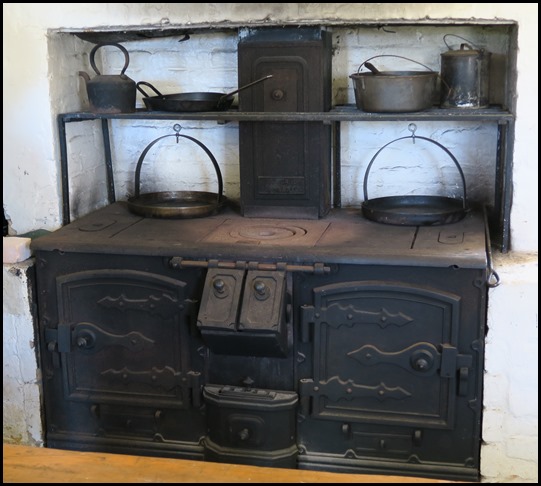 In the
building at the back of the house, used in hotel days, was this wonderful, original stove.
 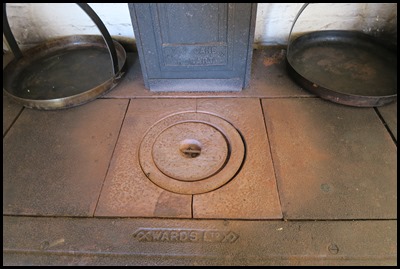 Wards Ltd. of Hobart. Still used in many homes
today.
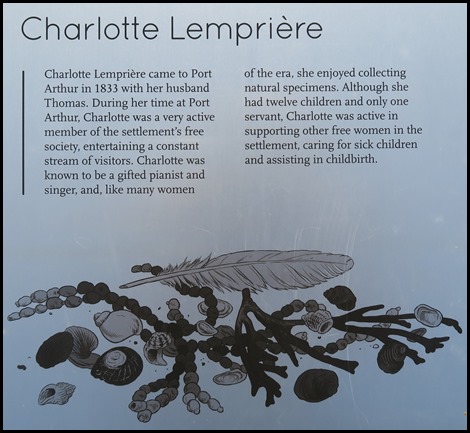 As we bimbled about the site we saw
many posts with snippets, this one for Charlotte
Lempriere.
Always nice to find out more about people of the era:- Thomas James Lempriere (1796–1852) artist and government official, was born on the 11th of January 1796 at Hamburg, Germany, where his father, Thomas Lempriere, a Jersey banker and merchant, was working. An adventurous early life included being imprisoned with his father by Napoleon at Verdun in 1803, although the 7-year-old boy was soon returned to his mother, Harriet née Allen, in England. Internment: He served the Commissariat Department in France, Flanders and the West Indies (1815–16), then was employed in the counting house of cousins, T and W March and Co, London. Under their auspices, Lempriere sailed for Van Diemen's Land (Tasmania) on the Regalia, arriving in Hobart in 1822 to commence his own business. Following a short and unsuccessful period as a merchant, he joined the Commissariat Department and served as storekeeper on Maria Island in 1826. Shortly after he was transferred to Sarah Island where he worked for the next five years. He returned to Hobart in 1831 before moving to Port Arthur as Senior Clerk in 1833. He was to remain at Port Arthur until 1848 and was promoted to Commissary General in 1844. In 1848 he spent a short time as Commissary Officer in Oatlands before moving to Hong Kong as Assistant Commissary General. He was recalled to England and contracted dysentery on the voyage and died at sea on the 6th of January 1852 en route to Aden, having been invalided home to England from a post in Hong Kong. He was buried with military honours, in Aden. Marriage: A shipboard romance resulted in his marriage to Charlotte Smith in 1823, and their large family was born over twenty years from 1824. Lempriere was prominent in the development of the Bank of Van Diemen's Land, but his Hobart business failed and by September 1825 he was insolvent. He rejoined the Commissariat Department and as well as working in Hobart Town, his duties took him to posts at the major penal settlements in Van Diemen's Land: Macquarie Harbour, Maria Island and Port Arthur. He served at the last in 1833-48 and there wrote his account of the penal settlements which was published in parts in the Tasmanian Journal of Natural Science (Hobart Town 1842-46).
Painting: Thomas Lempriere (self portrait) was of note as an artist of sketches, scenic water colours and portraits in oils. At least 135 of his works are in private or state collections. His interest in painting was not developed until comparatively late in life and he displayed an almost childlike pleasure when the sculptor Benjamin Law commended his efforts in January 1837: 'He was greatly astonished that anybody at such an age had begun to paint, a compliment to my abilities, but alas showing how much I have aged'.Portraiture was Lempriere's forte and comprises the major part of his work. His best-known portraits are probably the early ones of his commandant at Port Arthur, Captain Charles O'Hara Booth, and his wife Elizabeth Charlotte, but Lempriere's diaries document many others, a good percentage of which survive, largely with the families for whom they were painted. Other activities: He planned the Port Arthur church, took services there and was a prominent Mason. From his time at Sarah Island, Lempriere collected fish specimens for the marine naturalist, Sir John Richardson, and mammals, birds and insects for William Swainson, to whom he was introduced through a gift of Swainson's Naturalist's Guide. Lempriere formed a museum at Port Arthur in 1837 and kept tidal and meteorological information, and a skate named in his honour (Raja lemprieri) testifies to his scientific interests. Lempriere played the bugle horn and key bugle, spoke several languages and was a Francophile and inveterate diarist.One of his sons, John Everad died aged twenty five months, on the 21st of February 1845, he is buried on the Isle of the Dead.After Thomas’s death Charlotte was left in difficult circumstances and with four young children still at home. She spent the latter years of her life at the home of her daughter, Emily, who was born at Port Arthur in 1842, in Bellerieve. She died in 1890 at the age of eighty seven. Emily became a social activist and was married to Henry Dobson who was the Tasmanian Premier between 1892 and 1894. Their sons established the well known Lempriere Wool Brokerage company in Melbourne.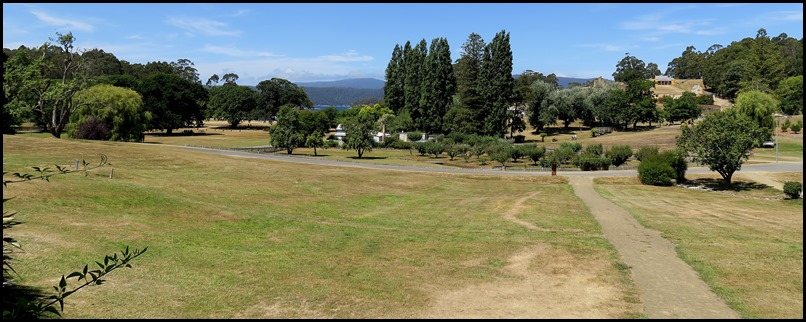 The view from the front porch – hard to imagine that this
could ever have been a penal establishment.
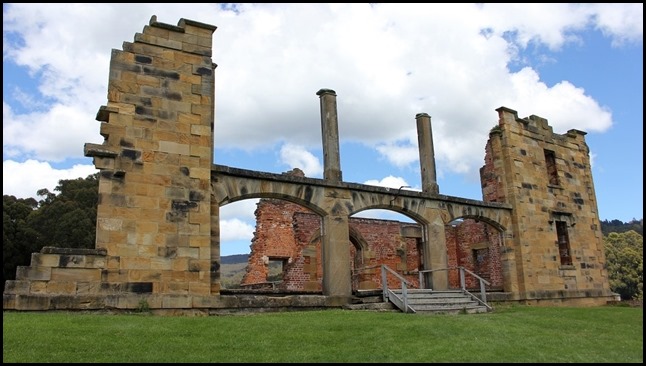 We walked over to the hospital, built above the prisoners’ barracks on Settlement Hill in 1841-1842, the hospital was the third constructed at Port Arthur. The hospital included four eighteen-bedded wards, a kitchen, baking room, laundry and morgue and was staffed by a doctor and a number of untrained convict orderlies. Port Arthur’s convicts laboured in heavy industries such as timber-getting, an inherently dangerous job that meant accident victims were common inmates at the hospital. During busy times the patients were often segregated by religion with Roman Catholics in one ward and Protestants in another. The administrators and their families were generally confined in their homes. The hospital building was sold to the Catholic Church in the 1890’s, it was due to be used as a boys’ college until it was damaged by a bushfires in 1895. Insurance money was used to rebuild it only for it to become the victim of the 1897 fires and the church abandoned the project.
The Hospital on the hill behind the Pauper’s Mess.
The ruin is now stabilised, with the footprint of the east wing marked out. The small building to the rear was the hospital laundry. Many of the original wooden buildings, including a hospital, stood in front of the convict hospital. Finally, a picture of the hospital, top right, behind the imposing facade of the Penetentiary.
. ALL IN ALL STEPPING BACK IN
TIME
INTERESTING
TOUR |
